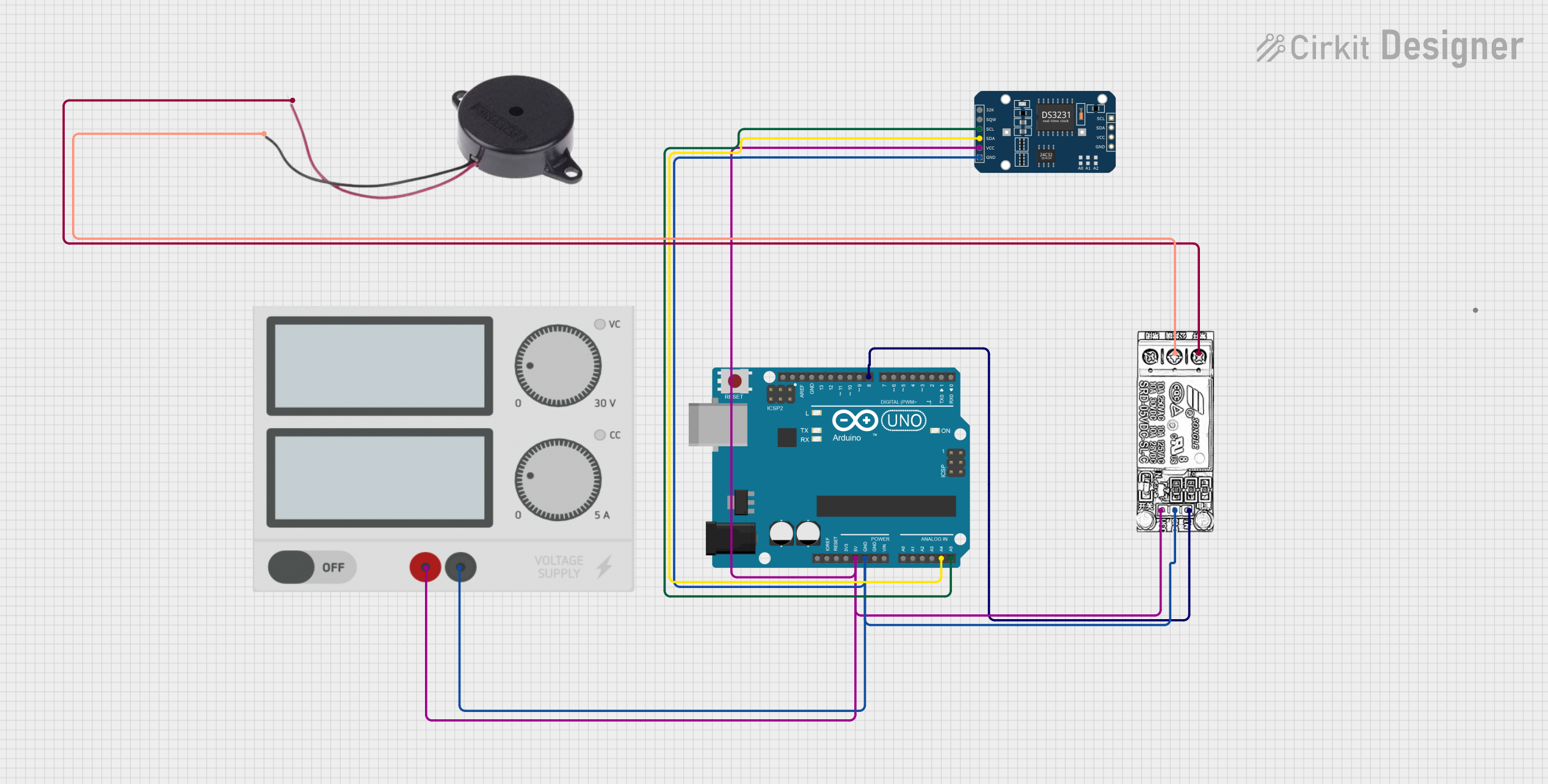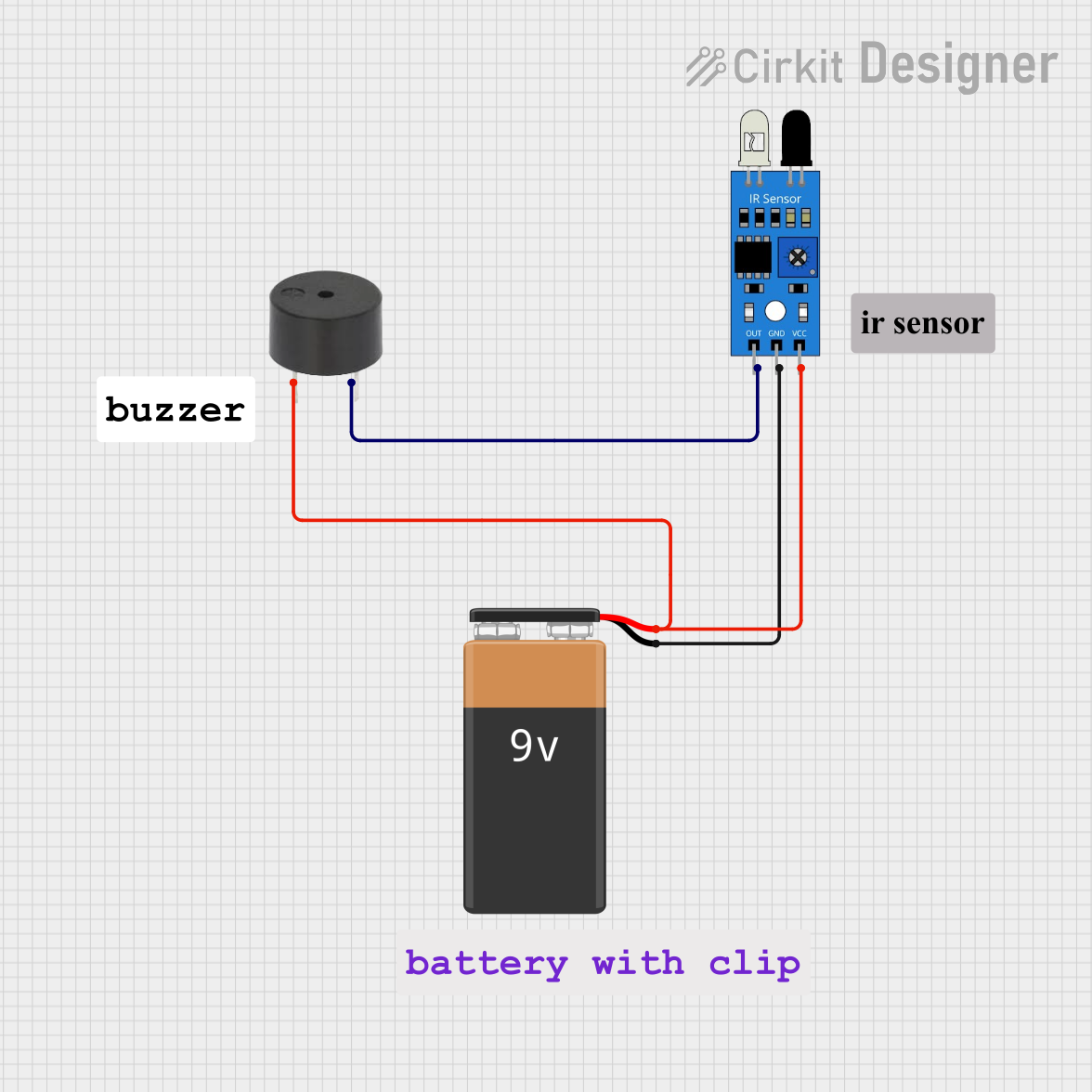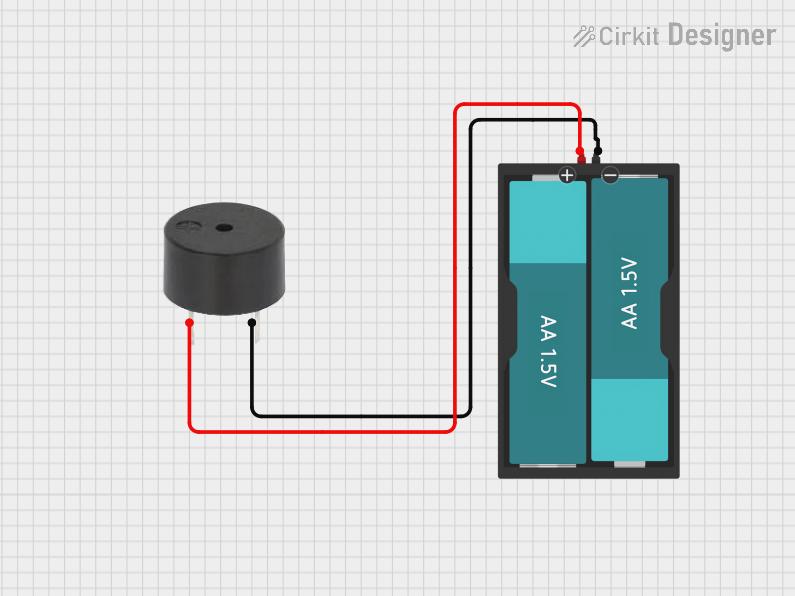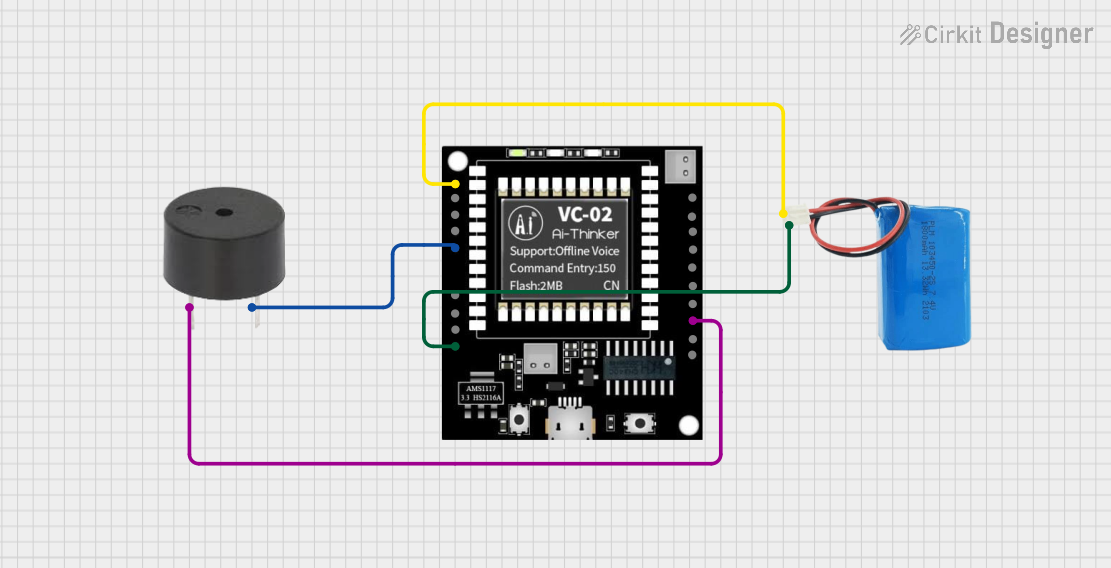
How to Use Buzzer: Examples, Pinouts, and Specs

 Design with Buzzer in Cirkit Designer
Design with Buzzer in Cirkit DesignerIntroduction
A buzzer is an audio signaling device that produces sound when an electric current passes through it. It is widely used in various electronic applications to provide audible alerts or notifications. Buzzers are commonly found in alarms, timers, household appliances, and embedded systems. They are available in two main types: active buzzers, which generate sound when powered, and passive buzzers, which require an external signal to produce sound.
Explore Projects Built with Buzzer

 Open Project in Cirkit Designer
Open Project in Cirkit Designer
 Open Project in Cirkit Designer
Open Project in Cirkit Designer
 Open Project in Cirkit Designer
Open Project in Cirkit Designer
 Open Project in Cirkit Designer
Open Project in Cirkit DesignerExplore Projects Built with Buzzer

 Open Project in Cirkit Designer
Open Project in Cirkit Designer
 Open Project in Cirkit Designer
Open Project in Cirkit Designer
 Open Project in Cirkit Designer
Open Project in Cirkit Designer
 Open Project in Cirkit Designer
Open Project in Cirkit DesignerTechnical Specifications
Below are the general technical specifications for a typical buzzer. Note that specific values may vary depending on the manufacturer and model.
General Specifications
- Operating Voltage: 3V to 12V (commonly 5V)
- Current Consumption: 10mA to 50mA
- Sound Frequency: 2 kHz to 4 kHz (typical)
- Sound Pressure Level (SPL): 85 dB to 100 dB at 10 cm
- Type: Active or Passive
- Operating Temperature: -20°C to 70°C
Pin Configuration and Descriptions
The buzzer typically has two pins, as described below:
| Pin | Name | Description |
|---|---|---|
| 1 | Positive (+) | Connect to the positive terminal of the power supply or control signal (e.g., 5V). |
| 2 | Negative (-) | Connect to the ground (GND) of the circuit. |
Note: For active buzzers, simply applying a voltage will produce sound. For passive buzzers, a PWM (Pulse Width Modulation) signal is required to generate sound.
Usage Instructions
How to Use the Buzzer in a Circuit
- Identify the Type of Buzzer: Determine whether the buzzer is active or passive. Active buzzers are easier to use as they only require a DC voltage, while passive buzzers need a PWM signal.
- Connect the Pins:
- Connect the positive pin of the buzzer to the power supply or control signal (e.g., a microcontroller pin).
- Connect the negative pin to the ground (GND) of the circuit.
- Power the Buzzer:
- For an active buzzer, apply the appropriate voltage (e.g., 5V) to the positive pin to produce sound.
- For a passive buzzer, generate a PWM signal from a microcontroller to drive the buzzer.
Example: Connecting a Buzzer to an Arduino UNO
Below is an example of how to connect and control a passive buzzer using an Arduino UNO.
Circuit Diagram
- Connect the positive pin of the buzzer to Arduino digital pin 9.
- Connect the negative pin of the buzzer to the GND pin of the Arduino.
Arduino Code
// Example code to control a passive buzzer with Arduino UNO
// This code generates a tone on the buzzer using the tone() function.
#define BUZZER_PIN 9 // Define the pin connected to the buzzer
void setup() {
pinMode(BUZZER_PIN, OUTPUT); // Set the buzzer pin as an output
}
void loop() {
tone(BUZZER_PIN, 1000); // Generate a 1 kHz tone on the buzzer
delay(1000); // Wait for 1 second
noTone(BUZZER_PIN); // Stop the tone
delay(1000); // Wait for 1 second
}
Important Considerations and Best Practices
- Voltage Compatibility: Ensure the operating voltage of the buzzer matches the power supply or control signal.
- Current Limitation: If the buzzer draws more current than the microcontroller pin can supply, use a transistor or MOSFET as a driver.
- Sound Level: Place the buzzer in an open area for maximum sound output. Avoid obstructing the sound hole.
- Type Selection: Use an active buzzer for simple applications and a passive buzzer for more control over sound frequency and patterns.
Troubleshooting and FAQs
Common Issues and Solutions
No Sound from the Buzzer:
- Cause: Incorrect wiring or insufficient voltage.
- Solution: Verify the connections and ensure the power supply matches the buzzer's operating voltage.
Low or Distorted Sound:
- Cause: Insufficient current or obstructed sound hole.
- Solution: Check the current supply and ensure the buzzer is not blocked.
Buzzer Not Responding to PWM Signal:
- Cause: Using an active buzzer instead of a passive one.
- Solution: Confirm the type of buzzer and use a passive buzzer for PWM control.
Overheating:
- Cause: Exceeding the voltage or current rating.
- Solution: Use a resistor or driver circuit to limit the current.
FAQs
Q: Can I use a buzzer with a 3.3V microcontroller?
A: Yes, but ensure the buzzer operates at 3.3V. If not, use a transistor or MOSFET to drive the buzzer with a higher voltage.Q: How do I generate different tones with a passive buzzer?
A: Use thetone()function in Arduino to generate different frequencies, which correspond to different tones.Q: Can I use a buzzer for continuous sound?
A: Yes, for an active buzzer, simply apply a constant voltage. For a passive buzzer, generate a continuous PWM signal.Q: What is the difference between active and passive buzzers?
A: Active buzzers have an internal oscillator and produce sound when powered. Passive buzzers require an external signal to generate sound.